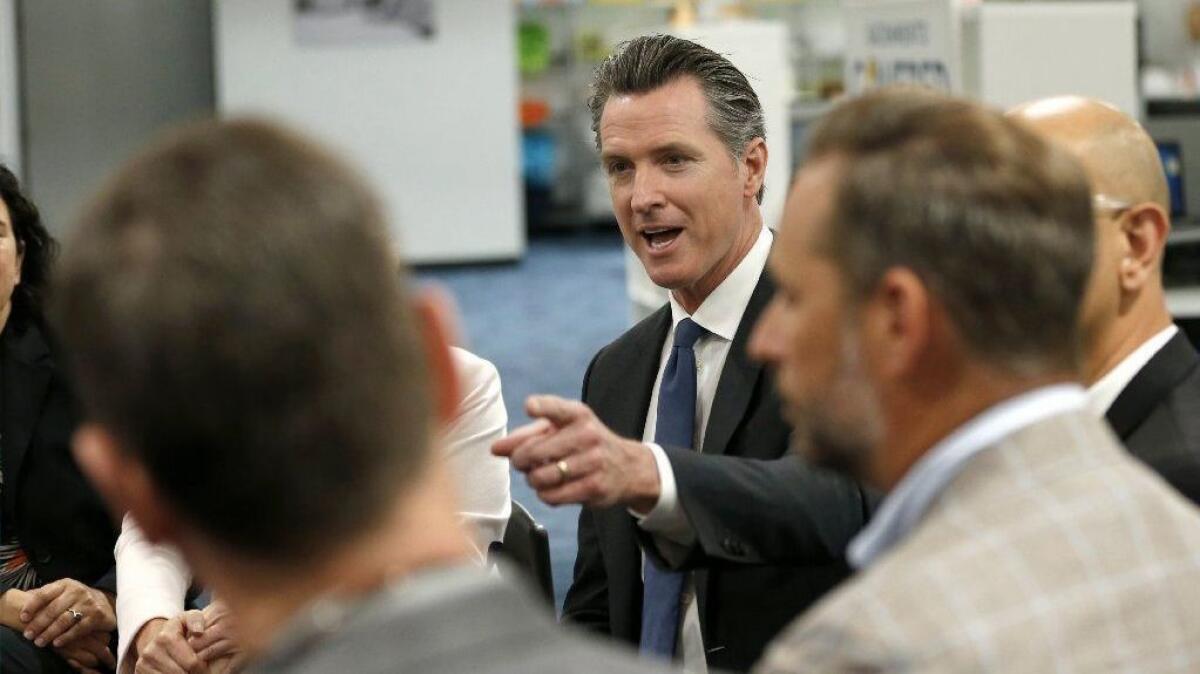Newsom’s tough sell on healthcare: persuading public on fines for those without coverage

Reporting from Sacramento — Five months after unveiling a sweeping plan to lower health insurance costs for middle-class Californians, Gov. Gavin Newsom now must sell the politically unpopular part of his proposal — hefty fines on those who do not have medical coverage.
On Tuesday, he launched his pitch by highlighting how the high cost of health insurance is hurting small-business owners, and he warned lawmakers that failing to approve the fees to fund expanded subsidies is a “bad decision.”
“Without the mandate, everybody’s premiums go up,” Newsom said during a discussion with healthcare leaders and small-business owners at a Covered California enrollment office in Sacramento.
Newsom will travel over the next five days across the state — visiting San Francisco, Los Angeles and San Diego — to promote his healthcare agenda. His plan includes consolidating prescription drug purchases to lower the cost of medications and allowing young immigrant adults who are in the U.S. illegally to be covered by Medi-Cal, the state’s health program for people with low incomes.
While those proposals have received the most attention, he said shoring up a health insurance market “vandalized” by the Trump administration is a top priority.
Newsom proposed in January that California reinstate a mandate that everyone enroll in health insurance after the federal government eliminated the requirement. The fees created by the individual mandate helped prop up the Affordable Care Act. Newsom proposed the state’s new penalties go toward expanding subsidies that lower the cost of buying insurance. If approved, both the individual mandate and the subsidies would begin Jan. 1.
Nearly 600,000 Californians paid $446 million in penalties to the federal government for not having health insurance in 2016, the most recent year for which data was available.
Newsom’s revised budget estimated that tax filers in the state would pay $317 million in fines for not carrying health insurance in 2020-21. The nonpartisan Legislative Analyst’s Office estimated that roughly 3.5 million people in California do not have health insurance, with those who are uninsured more likely to be low-income.
The burden on the poor was highlighted by opponents of the bill, including the California Nurses Assn. That argument may cause lawmakers may balk as well.
Two bills to create the mandate, which require majority approval, are working their way through the Legislature — SB 175 and AB 414. Both are scheduled to be heard in fiscal committees this week.
Newsom said the mandate and subsides will help alleviate uncertainty in the health insurance market and stabilize premiums that increase when younger healthy people do not buy in.
Individuals earning up to $72,000 and families of four making up to $150,000 would qualify for lower premiums under Newsom’s plan.
However, Newsom’s budget calls for the subsidies to sunset in three years and be adjusted in 2021 and 2022 based on how much the state takes in from the individual mandate penalty. That too could create uncertainty in the market, although Newsom said much less so than doing nothing.
“Perfect is not on the menu,” he said.
The California Nurses Assn. argues the fees target people who can’t afford health insurance in the first place, a key reason they are opposed. The powerful lobbying group also said that nothing would prevent insurance companies from raising rates and thus eliminating the benefit of the subsidies funded by the fees.
The nurses association has been the driving force behind efforts to create a single-payer system that covers every resident. Newsom earned the nurses association’s backing during his run for governor after pledging to lead the effort on single-payer healthcare.
On Tuesday, he said those efforts continue, but that subsidies and the individual mandate are the immediate band-aid needed to help Californians.
“That pursuit continues here in the state, but in the absence of the ideal, there is the pragmatic and there is the reality of today and how we provide relief today, and that is what we are pursuing in the interim,” Newsom said.
Follow @MelodyGutierrez on Twitter and sign up for our Essential Politics newsletter.
More to Read
Get the L.A. Times Politics newsletter
Deeply reported insights into legislation, politics and policy from Sacramento, Washington and beyond. In your inbox three times per week.
You may occasionally receive promotional content from the Los Angeles Times.











